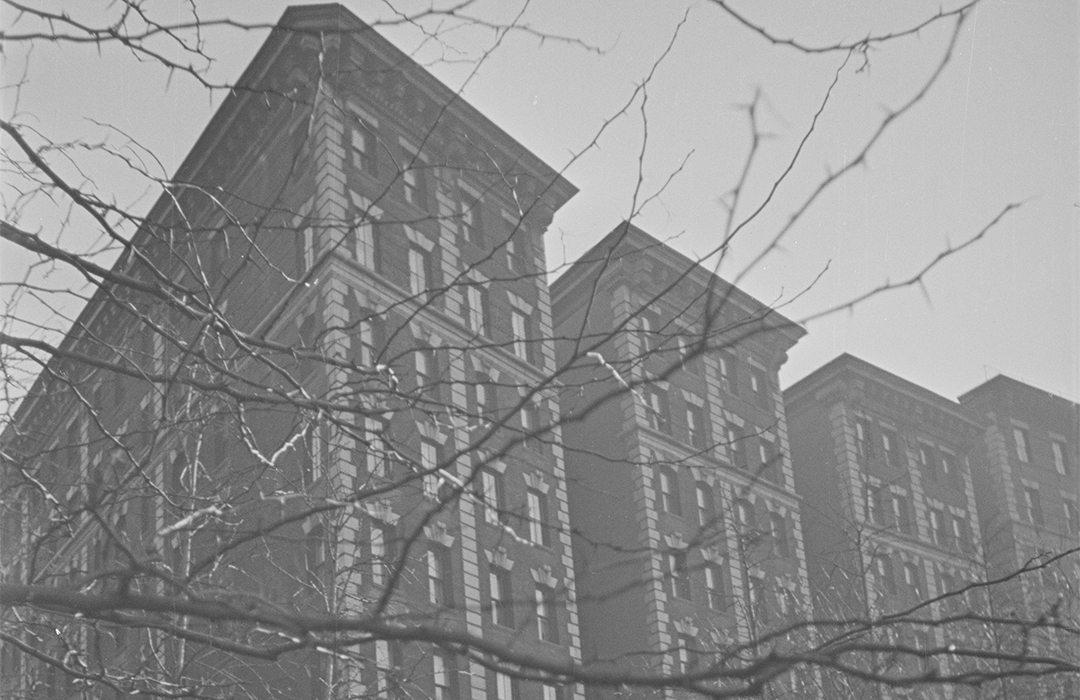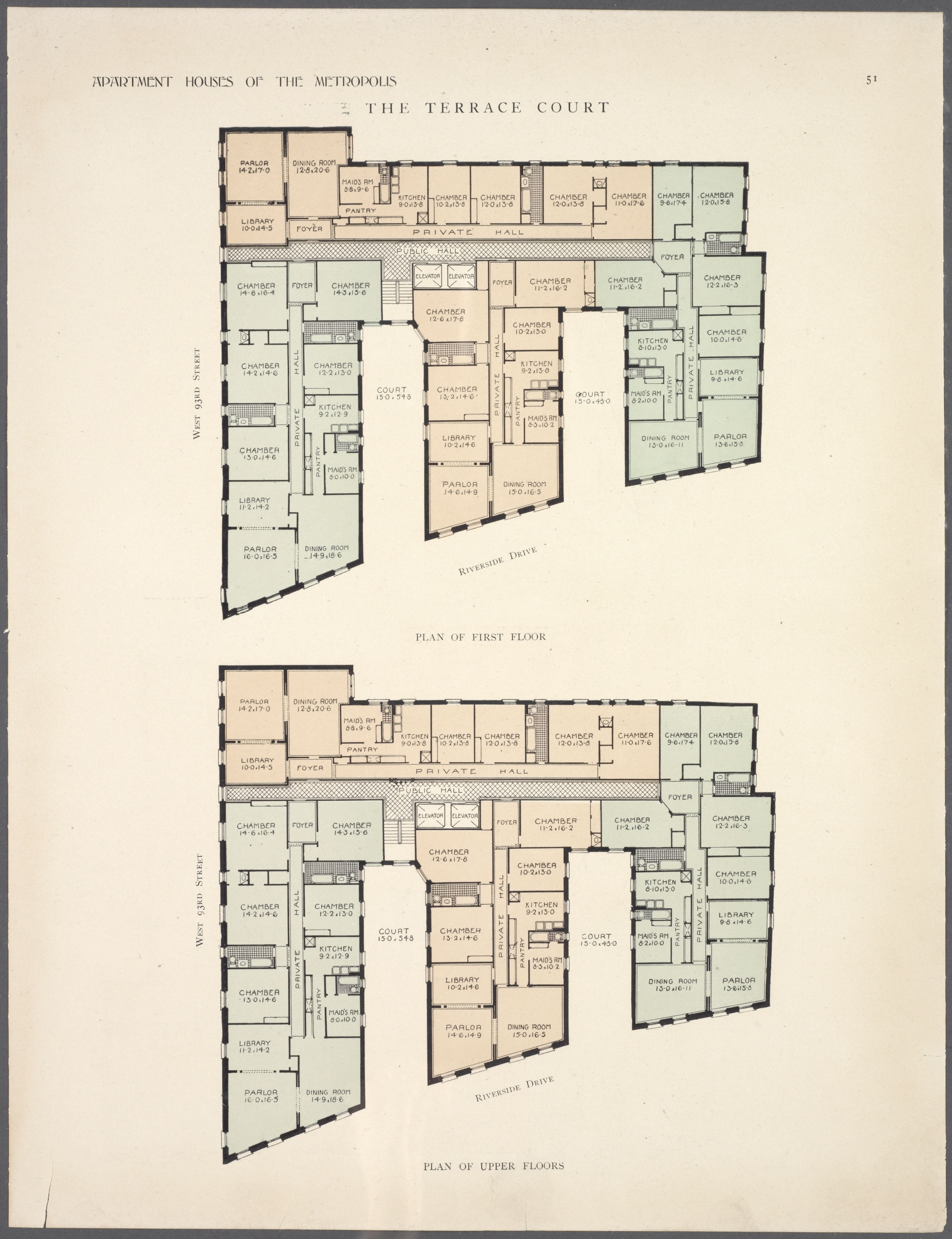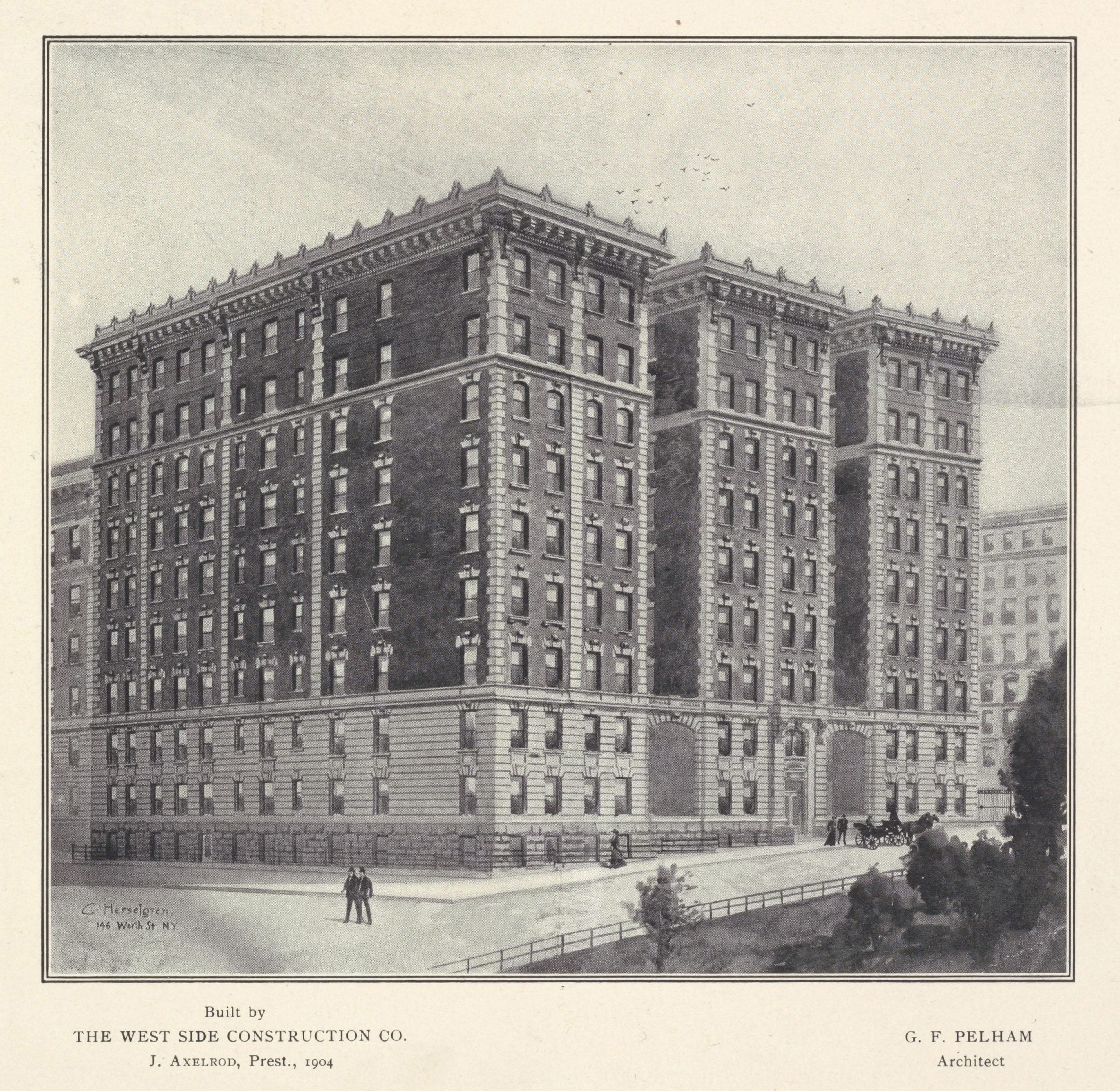
202 Riverside Drive, Terrace Court
by Tom Miller
In 1902, Jacob Axelrod incorporated the West Side Construction Co., which began erecting apartment houses on the Upper West Side, almost all of them designed by George F. Pelham. On October 1, 1904, the Record & Guide reported on plans for three more “high-class apartments” on Riverside Drive. One of them was the nine-story Terrace Court, to be built on the southeast corner of 93rd Street. The article noted, “There will be five apartments on a floor.”
Completed in 1905 at a cost of $350,000 (about $12.5 million in 2024), the Terrace Court had suites of nine or ten rooms. The Record & Guide said, “There is an unexcelled view of the river from this structure,” adding, “There is a terrace in front of the building, hence its name.” Pelham designed the building in an E-shape, allowing for deep courts that provided natural light and ventilation to the interior apartments. The three sections were joined by stone balustrades atop two-story segmental arches. The World’s Loose Leaf Album of Apartment Houses described,
The parlors and libraries are in mahogany finish, dining rooms antique oak, and all other rooms in white oak. Parquet floors in parlors, libraries, and dining rooms. All latest appointments installed. A United States mail chute, storage rooms and patent clothes dryers for use in stormy weather in the basement and two elevators in constant service, might be mentioned as a few of the appointments.
(The “patent clothes dryers” in the basement were used when inclement weather prohibited residents’ laundresses from using the clotheslines on the roof, unseen from the street.) An advertisement boasted, “The house must be seen to be appreciated. New parquet floors throughout and new electric fixtures of special designs.”
All the residents maintained a small domestic staff. The Heil family was looking for a second servant in May 1910. Mrs. Heil’s ad in The New York Times read, “Neat Girl, for general housework; three adults; liberal wages; apartment; personal references; another maid kept; light laundry work.”
18 families living in the Terrace Court were listed in Dau’s New York Blue Book of Society.
Typical of the residents were Francis M. Ferguson and his wife, the former Bertha Sweeney. The couple was married in October 1905 and had a young daughter. Born in Corydon, Iowa on October 1, 1863, Ferguson was the president of the Ferguson Contracting Company, which had built 3,000 miles of railroads. The New York Times said of Ferguson, “Among his most important contracts was the bringing of the Wabash Railroad into Pittsburgh.”
The 47-year-old was in Denver, Colorado, on business on June 23, 1910, when he “died suddenly…of fatty degeneration of the heart,” according to The New York Times. His body was brought back to New York City, and his funeral was held in the family’s Terrace Court apartment.
In 1911, 18 families living in the Terrace Court were listed in Dau’s New York Blue Book of Society. Among them were Colonel Walter Bryant Hotchkin, his wife, the former Mable L. Hall, and the Colonel’s widowed mother, Julia P. Cooke Hotchkin. The family’s country home was in Bellport, Long Island. (The Blue Book noted that Mrs. Hotchkin “receives Tuesday”). Julia Hotchkin was socially visible as her daughter-in-law. On March 10, 1912, for instance, The New York Times reported, “The New York County Andrew Jackson Chapter, Daughters of 1812, held its first annual meeting a short time ago in the home of the Regent, Mrs. William H. Hotchkin, 202 Riverside Drive.”
Siblings E. Teresa Rovira Newman and Joel Benito Rovira shared an apartment. They were the children of the late Benito Rovira, described by The New York Times as “a pioneer cigar manufacturer, who founded the Benito Rovira Company, and was a leader in the Spanish colony here.” Upon the death of E. Teresa’s husband, she moved in with her brother and sister-in-law, the former Mary L. Hadley. She died here on September 2, 1915. As had been the case with Francis M. Ferguson, her funeral was held in the apartment.
The Bennett E. Siegelsteins lived here in the early 1920s. Like the other residents, they summered outside of the city. On June 26, 1925, the New York Evening Post reported, “Mr. and Mrs. Bennett E. Sigelstein and their daughter, Miss Mariam Sigelstein, of 202 Riverside drive have opened their summer home at Hollywood avenue, West End, New Jersey, where they expect to spend the entire summer.”
Miriam would have one more summer with her parents in New Jersey. On June 18, 1926, The American Hebrew reported that the Siegelsteins “gave a dance and reception at the Park Lane on Tuesday on the occasion of their daughter Mariam’s engagement to Dr. David Green, author and child specialist.” The article noted, “the wedding will take place early in the Autumn.”
A week later, the governess in one of the apartments was driven to the breaking point. On July 29, 1926, the Cohoes, New York American reported that 28-year-old Theresa Gosens had pleaded guilty to shoplifting. She blamed her downfall on her job. “She said that the children got on her nerves,” said the article. She couldn’t do the work, so she was driven to stealing, she said.”
Shortly after 1:00 on the morning of February 14, 1936, resident John McHally discovered a fire in his kitchen. The New York Post said, “His feet and legs were burned slightly as he ran across the floor to give the alarm.” Rather than cross Riverside Drive to the park and suffer the frigid night air, 200 residents huddled in the lobby, “afraid to stay in their quarters,” according to the article. One of them was Florence Leach. When the 26-year-old heard the fire engines arriving, she became so excited that she “opened the door…so forcefully that a glass panel broke, showering her with pieces of glass.” Happily, the fire was confined to McHally’s apartment, and the other 200 residents were allowed to go back to theirs.
The article said police “found the Happersbergers ‘both excited and belligerent’ after what appeared to have been a long night party.”
In the 1960s, the number of apartments was doubled from five per floor to ten. Among the residents in 1964 were Lucien Happersberger and his wife, actress Diana Sands. Early on the morning of December 12, 1964, police responded three times to their apartment—first on a report of “a family fight going on,” the second to a call of an injured person,” and the third responding “to neighbors calls from two apartments on the 6th floor,” according to the Amsterdam News. The article said police “found the Happersbergers ‘both excited and belligerent’ after what appeared to have been a long night partyg.” Both parties were treated for cuts. The article ended by saying, “True to the show business traditions, however, Miss Sands, currently starring in ‘The Owl and the Pussycat,’ rested comfortably Tuesday and returned to her role on stage that night.”
Tragedy played out here on January 29, 1993. Auera Bonnie Vargas had lived in the building since 1966. Her father was the building’s superintendent. When she was not teaching part-time, she helped him with chores around the building. That afternoon, she stepped out of the building with her brother, Raymond Vargas Santiago, directly behind. At that moment, a man who had just robbed the nearby Chemical Bank branch turned the corner with police on his heels. He grabbed Auera, who screamed to her brother, “Shut the door. Shut the door,” not wanting him to be hurt. The gunman used the 41-year-old woman as a shield. But when the thief shot at the officers, hitting two of them, a gunfight broke out. One of the bullets fatally struck Auera.
Living here at the time of the tragedy were Bruce Detrick and his partner Joe Mondello. Born in 1941, Detrick was a composer, poet and playwright. He wrote pieces for the stage and scored several documentaries. He co-founded the Tamarand Foundation, which created roof gardens, children’s “playgardens,” music and the arts to AIDS care. In 1992 he was honored by the Municipal Arts Society for his work. He died of cancer at the age of 59 on June 30, 2001.
Tom Miller is a social historian and blogger at daytoninmanhattan.blogspot.com




